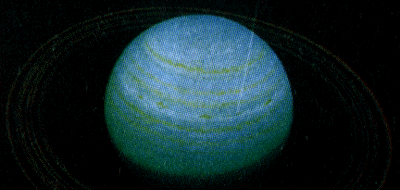

Uranus: around the Sun, "lying in the side".
Uranus is the seventh from the Sun great planet of the Solar system. It belongs to giant planets. It has some peculiarities. The axis of rotation is nearly perpendicular (98 deg) to the orbit plane and the rotation direction is opposite to the direction of turning around the Sun (the reverse rotation) this is observed only with Venus.
The composition and structure. Like other giant planets Uranus atmosphere consists mainly of hydrogen helium and methane. The theoretical model of Uranus structure is following its upper layer is a gasoliquid shell under which is an icy cloak (the water and ammonia ice) then comes the core of the solid soils. The cloak and the core mass is about 85-90% of all Uranus mass.The temperature in the centre of Uranus is near 10000K under the pressure 7-8 mln atmospheres (one atmosphere corresponds to one bar). The effective temperature determined from the heat radiation of the planet's surface is about 55R
The rings of Uranus.
Uranus has a ring system consisting of the pieces of coal-black "cob-web". The particles of these "cob-web" dimensions are some meters and reflects about 3% of the falling light
sellites of Uranus.Like Neptune and Saturn it Has a lot of satellites (to the 1998 they were 15). The first fore satellites were discovered from the Earth. That is Miranda (127km, 10^-7), Ariel (565km, 1,1*10^-5). The two last satellites, according to the theoretical valuing, suffer the different elements along the depth, as a result of which was a silicate core formation, cloak from the ice (water and ammonia) and an icy crust. The heat escaping during the differentiation leads to the depth heating which may cause their melting down. The next 10 Uranus's satellites (Cordilia, Porta, Rosalina, Belinda, Pack) were discovered from board the spaceship "Voyager-2" in 1985 - 1986.